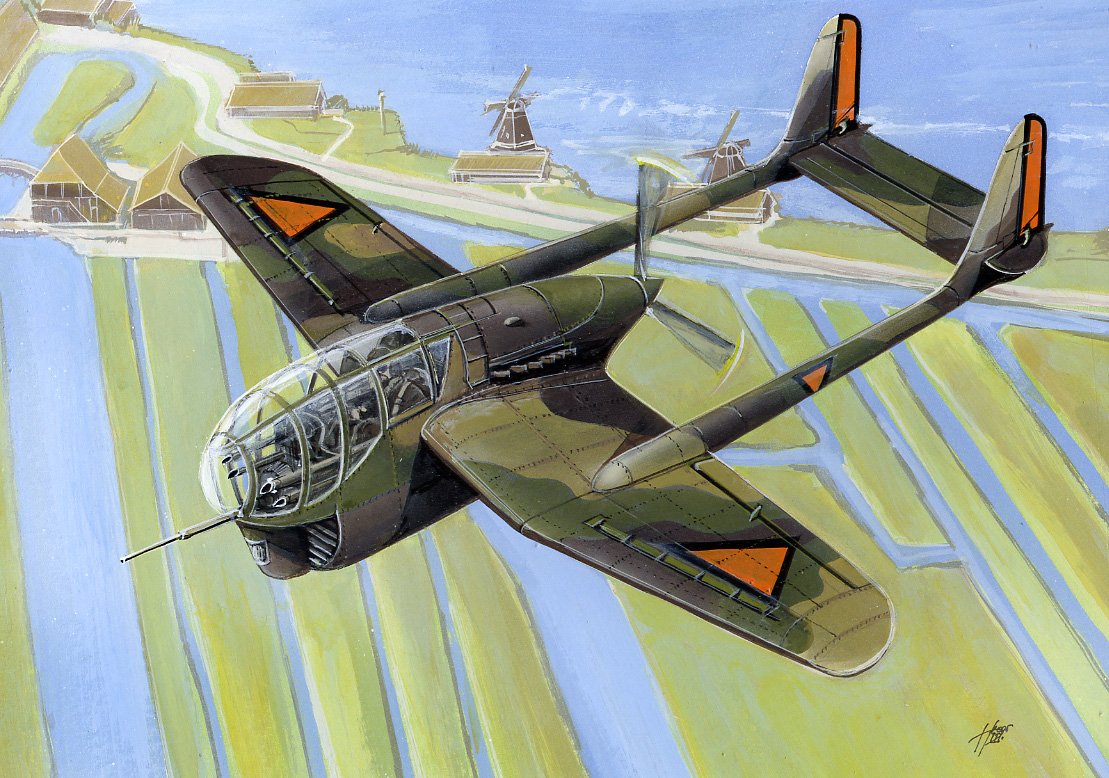Designed by TE Slot for the Dutch firm De Schelde, the S.21 was a single seat fighter which reached the advanced prototype stage. Construction commenced early in 1939. Slot believed that, with all the weight concentrated on the fighter's CG. the S.21 would make an excellent gun platform and offer a degree of maneuverability comparable with, if not superior to, that of more orthodox single-seat fighter configurations. Superb view with the firepower concentrated in the nose were to be other advantages.
Of course the concept was not new when you look at other designs of the period including the SAAB-21A, Vultee XP-54 and the original Bell XP-59 design. However, aspects that deviated from these designs included an extensively glazed cockpit and a semi-reclined seat for the pilot. The intended powerplant was to be a Daimler-Benz DB 600Ga 12-cylinder inverted-vee of 1,050hp. A three bladed prop was driven via an extension shaft. Danger for the pilot from the pusher prop when in the event of bailing out was to be solved by "jettisoning" the propeller just prior.
Not only was it intended to take on the interceptor role, low-level ground attack was also envisaged. A 23mm Madsen cannon was to be fixed for the interceptor role and flexible for ground attack role. This being achieved by an automatic stabilising system whereby the pilot only had to adjust the rudder while operating the flexible cannon mode. Other armament included four 7.9mm FN-Browning machine guns.
Estimated maximum speed of 367 mph at 13,125 ft, and a maximum continuous cruise of 323mph was "feasible".
Unfortunately, no opportunity to confirm these calculations was to present itself. The prototype was in final assembly in May 1940 when the Wehrmacht occupied the De Schelde factory. the airframe was transported to Utrecht where it was tested to destruction in the Zerlegebetrieb (Analysis Department).
Of course the concept was not new when you look at other designs of the period including the SAAB-21A, Vultee XP-54 and the original Bell XP-59 design. However, aspects that deviated from these designs included an extensively glazed cockpit and a semi-reclined seat for the pilot. The intended powerplant was to be a Daimler-Benz DB 600Ga 12-cylinder inverted-vee of 1,050hp. A three bladed prop was driven via an extension shaft. Danger for the pilot from the pusher prop when in the event of bailing out was to be solved by "jettisoning" the propeller just prior.
Not only was it intended to take on the interceptor role, low-level ground attack was also envisaged. A 23mm Madsen cannon was to be fixed for the interceptor role and flexible for ground attack role. This being achieved by an automatic stabilising system whereby the pilot only had to adjust the rudder while operating the flexible cannon mode. Other armament included four 7.9mm FN-Browning machine guns.
Estimated maximum speed of 367 mph at 13,125 ft, and a maximum continuous cruise of 323mph was "feasible".
Unfortunately, no opportunity to confirm these calculations was to present itself. The prototype was in final assembly in May 1940 when the Wehrmacht occupied the De Schelde factory. the airframe was transported to Utrecht where it was tested to destruction in the Zerlegebetrieb (Analysis Department).





4 comments:
I would love to see some wealthy hobbyist build a replica of one of these x-planes and fly it.
surprising if the number of machines that pass what we call "Kryptoaeronáutica" that is, we know exist but nothing more. This is strikingly different.
However, another alternative is interesting - the Netherlands is really preparing for war. They produce a lot of aircraft and mobilize at least 5% of the population, not just over one.
Wow, este artículo realmente me levantó el ánimo y me recordó que siempre hay un lado positivo. La prueba cps test alucinantemente divertida; ¡mi cerebro se ejercitó de verdad! debes visitar
Post a Comment